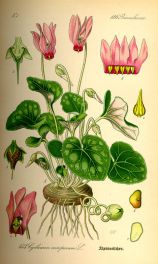Contrary Cyclamen
By Audrey Stallsmith

I had a plant which would not thrive,
Although I watered it with care,
I could not save the blossoms fair,
Nor even keep the leaves alive. . .
A lady sent it me, to prove
She held my friendship in esteem;
I would not have it as she said,
I wanted it to be for love;
And now not even friends we seem,
And now the cyclamen is dead.
Robert Fuller Murray, "Cyclamen"
The poet above may have given up too soon--on the cyclamen, if not the lady--as I will explain below. I only call cyclamen contrary because it operates differently than other plants. While most sprout in the spring and die back in the fall, cyclamens just begin to emerge in the autumn. They then remain green all winter, and die back during the summer.
I am speaking of hardy cyclamens such as hederifolium (AKA europaeum or purpurascens). The type widely available as a holiday plant this time of year, Cyclamen persicum, can only be grown outdoors in warmer climates. But, for those of us who purchase it as a houseplant, it does run through a cycle similar to that of its more rugged kin.
So don't throw out your potted Christmas cyclamen just because it begins to yellow as spring approaches. (The poet's plant may not really have been dead after all, just sleeping.) As long as the tuber still feels firm to the touch, your cyclamen can probably be resurrected at the proper season.
I kept mine last year and allowed it to go dormant when it seemed ready to do so. I then turned the pot on its side, so I would remember not to water the plant during the summer. Once I saw sprouts beginning to emerge from the tuber in the fall, I began to apply H2O again.
My plant has put out an abundance of new leaves already. And, although it hasn't yet bloomed, it does appear to be sending up buds from its base.
Cyclamen flowers, when they emerge, look upside-down. They appear as if they are being attacked by a windstorm from below, since the (reflexed) petals are swept up higher than the bloom's center. Perhaps the impression that the cyclamen "hangs its head" is why it stands for "diffidence" in the Language of Flowers. The blooms of some hardy types smell of violets, with hederifolium reportedly having the strongest scent.
The plant's "backward" cycle allows it to survive in the Mediterranean region where it originated. It is able to "sleep" through the hottest and driest part of the year there, only to pop up again once the cooler temperatures and rains return.
Cyclamen derives from the Greek cyclos ("circle"). But whether that term refers to the inner ring from which the petals fly up or to the plant's round tuber or spiralling seed stalks is anybody's guess. The seeds have a sticky-sweet coating attractive to ants, so those insects help distribute the flower
Cyclamen is also known as sowbread or hog's bread, because wild swine like to root up the tubers. Those tubers contain a toxin called cyclamin which renders them somewhat poisonous. In fact cyclamen was once used for "stunning" or stupefying fish, to make them easy to gather by hand. The tubers' toxin apparently doesn't bother hogs. But, then, pigs aren't known for their sensitive digestive systems!
The poison is apparently neutralized by heat, as the ancients used to make love potions from roasted cyclamen. "Being beaten and made up into trochisches, or little flat cakes," John Gerard writes,"it is reputed to be a good amorous medicine to make one in love, if it be inwardly taken."
Like many somewhat poisonous plants, cyclamen has also been used as a violent purgative (laxative) and to kill worms. It may be possible for the toxin to be absorbed through the skin, as people used to rub their stomachs with an ointment called arthainta for the purposes mentioned above. (Cyclamen was originally known as artanitae cyclaminis and then simply as arthanita during the 1600's and 1700's.).
Sowbread is probably too dangerous for use as a medicinal these days, when there are much less if-fey alternatives available. But its lovely heart-shaped leaves, usually ringed with patterns of silver, make the plant an attractive addition to the garden even when it's not in bloom.
If you want to grow hardy cyclamens, keep in mind that they prefer dry and shady conditions. They also need to be planted quite shallowly, with the top of the bulb level with the top of the soil. When sowing hardy cyclamens this spring, I chose a gritty cactus mix, which the seeds seemed to like as they sprouted quite thickly.
We are, however, on the edge of their hardiness zone here in western Pennsylvania. Although hederifolium and coum are supposed to survive in Zone 5, some of the others are doubtful. So I plan to keep the little seedlings under grow lights in the basement this winter. At least until they are large enough to have some chance of withstanding the chipmunks!
But any of us can enjoy the florist cyclamens that are widely available at this time of year. Just remember to keep their soil damp but not soggy, and try to avoid pouring water directly into the centers of the tubers.
Be sure that you also give your cyclamens the coolest indoor conditions possible. You don't want these particular plants to get the impression that summer has come early! Once that season does arrive, however, just tip them over and "tuck them in" until autumn.
Cyclamen purpurascens image is from Flora von Deutschland Osterreich und der Schweiz by Otto Wilhelm Thome, courtesy of the TAMU Vascular Plant Image Library.








